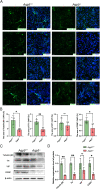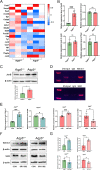Regulation of Axon Guidance by Slit2 and Netrin-1 Signaling in the Lacrimal Gland of Aqp5 Knockout Mice
- PMID: 37707834
- PMCID: PMC10506685
- DOI: 10.1167/iovs.64.12.27
Regulation of Axon Guidance by Slit2 and Netrin-1 Signaling in the Lacrimal Gland of Aqp5 Knockout Mice
Abstract
Purpose: Dry eye disease (DED) is multifactorial and associated with nerve abnormalities. We explored an Aquaporin 5 (AQP5)-deficiency-induced JunB activation mechanism, which causes abnormal lacrimal gland (LG) nerve distribution through Slit2 upregulation and Netrin-1 repression.
Methods: Aqp5 knockout (Aqp5-/-) and wild-type (Aqp5+/+) mice were studied. LGs were permeabilized and stained with neuronal class III β-tubulin, tyrosine hydroxylase (TH), vasoactive intestinal peptide (VIP), and calcitonin gene-related peptide (CGRP). Whole-mount images were acquired through tissue clearing and 3D fluorescence imaging. Mouse primary trigeminal ganglion (TG) neurons were treated with LG extracts and Netrin-1/Slit2 neutralizing antibody. Transcription factor (TF) prediction and chromatin immunoprecipitation-polymerase chain reaction (ChIP-PCR) experiments verified the JunB binding and regulatory effect on Netrin-1 and Slit2.
Results: Three-dimensional tissue and section immunofluorescence showed reduced LG nerves in Aqp5-/- mice, with sympathetic and sensory nerves significantly decreased. Netrin-1 was reduced and Slit2 increased in Aqp5-/- mice LGs. Aqp5+/+ mice LG tissue extracts (TEs) promoted Aqp5-/- TG neurons axon growth, but Netrin-1 neutralizing antibody (NAb) could inhibit that promotion. Aqp5-/- mice LG TEs inhibited Aqp5+/+ TG axon growth, but Slit2 NAb alleviated that inhibition. Furthermore, JunB, a Netrin-1 and Slit2 TF, could bind them and regulate their expression. SR11302, meanwhile, reversed the Netrin-1 and Slit2 shifts caused by AQP5 deficiency.
Conclusions: AQP5 deficiency causes LG nerve abnormalities. Persistent JunB activation, the common denominator for Netrin-1 suppression and Slit2 induction, was found in Aqp5-/- mice LG epithelial cells. This affected sensory and sympathetic nerve fibers' distribution in LGs. Our findings provide insights into preventing, reversing, and treating DED.
Conflict of interest statement
Disclosure:
Figures








Similar articles
-
Reticulated Retinoic Acid Synthesis is Implicated in the Pathogenesis of Dry Eye in Aqp5 Deficiency Mice.Invest Ophthalmol Vis Sci. 2024 Jul 1;65(8):25. doi: 10.1167/iovs.65.8.25. Invest Ophthalmol Vis Sci. 2024. PMID: 39017635 Free PMC article.
-
Aquaporin5 Deficiency Aggravates ROS/NLRP3 Inflammasome-Mediated Pyroptosis in the Lacrimal Glands.Invest Ophthalmol Vis Sci. 2023 Jan 3;64(1):4. doi: 10.1167/iovs.64.1.4. Invest Ophthalmol Vis Sci. 2023. PMID: 36626177 Free PMC article.
-
Acupuncture promotes tear secretion by up-regulating VIP/cAMP/PKA/AQP5 signaling in guinea pigs with aqueous tear deficiency dry eye.Zhen Ci Yan Jiu. 2023 Oct 25;48(10):1025-1032. doi: 10.13702/j.1000-0607.20230061. Zhen Ci Yan Jiu. 2023. PMID: 37879953 Chinese, English.
-
Changes of the ocular surface and aquaporins in the lacrimal glands of rabbits during pregnancy.Mol Vis. 2011;17:2847-55. Epub 2011 Nov 9. Mol Vis. 2011. PMID: 22128232 Free PMC article.
-
Development of high-throughput lacrimal gland organoid platforms for drug discovery in dry eye disease.SLAS Discov. 2022 Apr;27(3):151-158. doi: 10.1016/j.slasd.2021.11.002. Epub 2021 Dec 4. SLAS Discov. 2022. PMID: 35058190 Review.
Cited by
-
Nissl Granules, Axonal Regeneration, and Regenerative Therapeutics: A Comprehensive Review.Cureus. 2023 Oct 28;15(10):e47872. doi: 10.7759/cureus.47872. eCollection 2023 Oct. Cureus. 2023. PMID: 38022048 Free PMC article. Review.
-
Screening of pathologically significant diagnostic biomarkers in tears of thyroid eye disease based on bioinformatic analysis and machine learning.Front Cell Dev Biol. 2024 Oct 30;12:1486170. doi: 10.3389/fcell.2024.1486170. eCollection 2024. Front Cell Dev Biol. 2024. PMID: 39544368 Free PMC article.
References
-
- Stern ME, Beuerman RW, Fox RI, Gao J, Mircheff AK, Pflugfelder SC.. The pathology of dry eye: the interaction between the ocular surface and lacrimal glands. Cornea . 1998; 17(6): 584–589. - PubMed
Publication types
MeSH terms
Substances
LinkOut - more resources
Full Text Sources
Molecular Biology Databases
Research Materials
Miscellaneous

